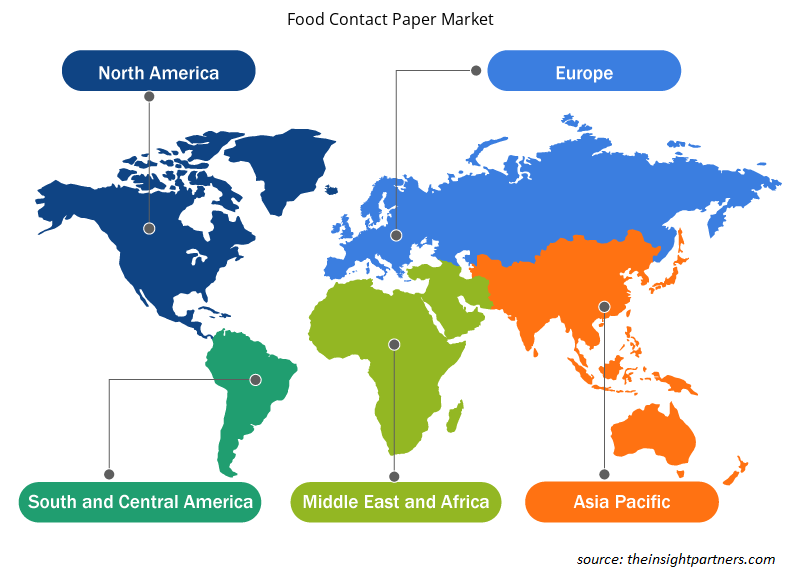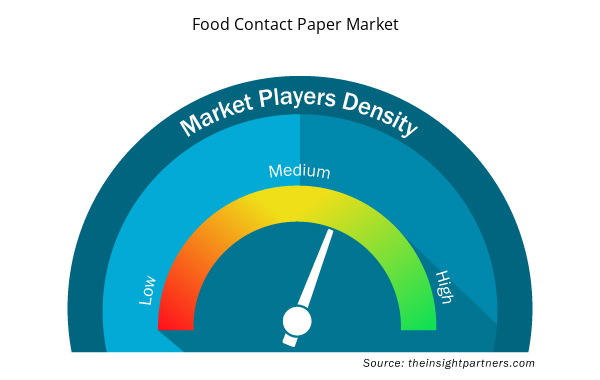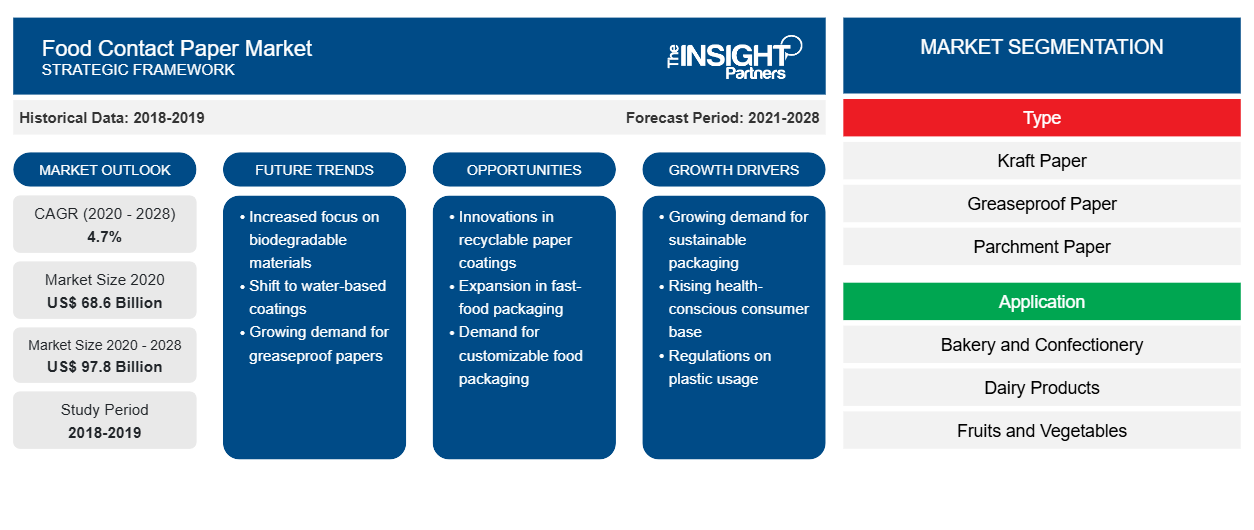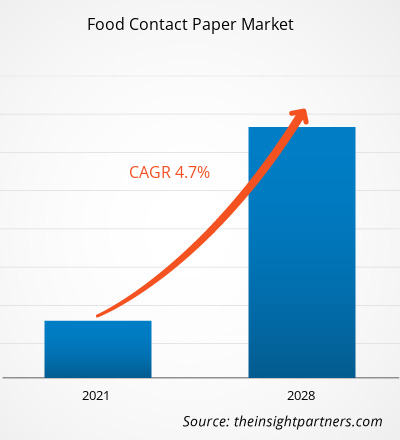Nel 2020, il mercato della carta a contatto con gli alimenti era valutato 68,6 miliardi di dollari USA e si prevede che raggiungerà i 97,8 miliardi di dollari USA entro il 2028; si prevede una crescita a un CAGR del 4,7% dal 2021 al 2028.
Le carte per il contatto con gli alimenti sono utilizzate come materiali di imballaggio primari per vari prodotti alimentari, come prodotti da forno, dolciumi, carne, snack e prodotti di macinazione dei cereali. Le carte sono alternative sostenibili a molti altri materiali di imballaggio alimentare, come plastica e vetro. Le crescenti iniziative delle aziende per ridurre la loro impronta di carbonio stanno influenzando l'adozione di carta per il contatto con gli alimenti in tutto il mondo. L'aumento della domanda di imballaggi alimentari sostenibili ed ecologici ha anche aumentato la domanda di imballaggi di carta alimentare.
Nel 2020, l'Asia Pacifica ha dominato il mercato globale della carta a contatto con gli alimenti e si prevede che continuerà a dominare durante il periodo di previsione. La crescente industria della ristorazione nei paesi asiatici, la crescente consapevolezza ambientale, le crescenti iniziative governative per vietare gli imballaggi in plastica in diversi paesi asiatici dovrebbero accelerare la domanda di soluzioni di imballaggio ecologiche e sostenibili, che guiderebbero la crescita del mercato della carta a contatto con gli alimenti nell'Asia Pacifica.
Personalizza questo report in base alle tue esigenze
Riceverai la personalizzazione gratuita di qualsiasi report, comprese parti di questo report, o analisi a livello nazionale, pacchetto dati Excel, oltre a usufruire di grandi offerte e sconti per start-up e università
- Scopri le principali tendenze di mercato in questo rapporto.Questo campione GRATUITO includerà analisi di dati che spaziano dalle tendenze di mercato alle stime e alle previsioni.
Molti settori, come quello dei prodotti chimici e dei materiali, hanno dovuto affrontare sfide senza precedenti a causa della pandemia di COVID-19. A causa della carenza di materie prime e manodopera, della chiusura delle fabbriche e di altre difficoltà operative in base ai protocolli di sicurezza COVID-19, i produttori di prodotti per imballaggio hanno dovuto affrontare una contrazione delle vendite durante i primi mesi della pandemia. Inoltre, il cambiamento nello stile di vita dei consumatori e le loro mutevoli abitudini alimentari hanno ridotto il consumo di cibo pronto all'uso e da esterno a causa della diffusione del virus, il che ha influenzato negativamente la domanda di carte per il contatto con gli alimenti. Tuttavia, poiché diversi paesi stanno revocando il lockdown con adeguate misure precauzionali, è probabile che la domanda di carte per il contatto con gli alimenti torni in carreggiata. Poiché il lockdown è stato imposto in vari paesi, il settore dell'e-commerce ha assistito a una domanda significativa di vari prodotti, come alimenti confezionati e generi alimentari, tra cui frutta e verdura fresca, a causa della chiusura dei negozi offline, che ha alimentato l'utilizzo di carte per il contatto con gli alimenti.
Approfondimenti di mercato
Domanda crescente di soluzioni di imballaggio riciclabili e biodegradabili
L'imballaggio biodegradabile e riciclabile è stato un'alternativa interessante alle opzioni di imballaggio monouso sia per i consumatori che per i produttori. L'imballaggio per la ristorazione genera una notevole quantità di rifiuti nelle discariche negli Stati Uniti. Secondo un rapporto pubblicato dall'Agenzia per la protezione ambientale degli Stati Uniti, i rifiuti alimentari e gli imballaggi rappresentano la maggior parte dei materiali smaltiti in discarica negli Stati Uniti. Poiché l'imballaggio di carta è biodegradabile, è preferibile all'imballaggio riciclabile. L'uso di imballaggi alimentari riciclati aumenta le possibilità di contaminazione, con conseguenti potenziali effetti sull'ambiente e sulla salute umana. Le crescenti iniziative dei governi di tutto il mondo sull'uso di sacchetti di plastica monouso stanno spingendo la domanda di soluzioni di imballaggio riciclabili ma sostenibili, portando a una maggiore domanda di carte a contatto con gli alimenti.
Tipo Informazioni
In base al tipo, il mercato della carta a contatto con gli alimenti è segmentato incarta kraft, carta antigrasso, carta pergamena e altre. Il segmento della carta kraft ha detenuto la quota di mercato maggiore nel 2020. Le carte kraft naturali hanno fibre vergini pure, il che le rende una soluzione di imballaggio ideale per il contatto con gli alimenti. La carta è sempre più utilizzata per la produzione di vari prodotti di carta per il contatto con gli alimenti, come sacchetti di carta, sacchi di carta, carta da imballaggio e piatti di carta. La carta kraft naturale è sempre più utilizzata anche per realizzare sacchetti della spesa per frutta e verdura fresca grazie alla sua elevata resistenza.
Mondi; Westrock Company; Georgia-Pacific LLC; Twin River Paper Company; UPM; Ahlstrom-Munksjö; GM Packaging (UK) Ltd; Superiorpaper Pty Ltd. TopCare; e KRPA Holding CZ, sono tra i principali attori che operano nel mercato della carta a contatto con gli alimenti. I principali attori del mercato stanno adottando strategie come fusioni e acquisizioni e lanci di prodotti per espandere la loro presenza geografica e la loro base di consumatori.
Segnala i riflettori
- Tendenze progressive nel settore della carta a contatto con gli alimenti per aiutare gli operatori a sviluppare strategie efficaci a lungo termine
- Strategie di crescita aziendale adottate dalle aziende per garantire la crescita nei mercati sviluppati e in via di sviluppo
- Analisi quantitativa del mercato globale della carta a contatto con gli alimenti dal 2019 al 2028
- Stima della domanda di carta a contatto con gli alimenti in vari settori
- Analisi di Porter per illustrare l'efficacia degli acquirenti e dei fornitori che operano nel settore per prevedere la crescita del mercato
- Sviluppi recenti per comprendere lo scenario competitivo del mercato e la domanda di carta a contatto con gli alimenti
- Tendenze e prospettive di mercato, insieme ai fattori che guidano e frenano la crescita del mercato della carta a contatto con gli alimenti
- Comprensione delle strategie che sostengono l'interesse commerciale in relazione alla crescita del mercato globale della carta a contatto con gli alimenti, aiutando nel processo decisionale
- Dimensioni del mercato del vetro float in vari nodi del mercato
- Panoramica dettagliata e segmentazione del mercato globale della carta a contatto con gli alimenti, nonché delle dinamiche del settore
- Dimensioni del mercato della carta a contatto con gli alimenti in varie regioni con promettenti opportunità di crescita
Approfondimenti regionali sul mercato della carta a contatto con gli alimenti
Le tendenze regionali e i fattori che influenzano il Food Contact Paper Market durante il periodo di previsione sono stati ampiamente spiegati dagli analisti di Insight Partners. Questa sezione discute anche i segmenti e la geografia del Food Contact Paper Market in Nord America, Europa, Asia Pacifico, Medio Oriente e Africa, e Sud e Centro America.

- Ottieni i dati specifici regionali per il mercato della carta a contatto con gli alimenti
Ambito del rapporto di mercato sulla carta a contatto con gli alimenti
| Attributo del report | Dettagli |
|---|---|
| Dimensioni del mercato nel 2020 | 68,6 miliardi di dollari USA |
| Dimensioni del mercato entro il 2028 | 97,8 miliardi di dollari USA |
| CAGR globale (2020 - 2028) | 4,7% |
| Dati storici | 2018-2019 |
| Periodo di previsione | 2021-2028 |
| Segmenti coperti | Per tipo
|
| Regioni e Paesi coperti | America del Nord
|
| Leader di mercato e profili aziendali chiave |
|
Densità degli attori del mercato della carta a contatto con gli alimenti: comprendere il suo impatto sulle dinamiche aziendali
Il mercato della carta per contatto alimentare sta crescendo rapidamente, spinto dalla crescente domanda degli utenti finali dovuta a fattori quali l'evoluzione delle preferenze dei consumatori, i progressi tecnologici e una maggiore consapevolezza dei benefici del prodotto. Con l'aumento della domanda, le aziende stanno ampliando le loro offerte, innovando per soddisfare le esigenze dei consumatori e capitalizzando sulle tendenze emergenti, il che alimenta ulteriormente la crescita del mercato.
La densità degli operatori di mercato si riferisce alla distribuzione di aziende o società che operano in un particolare mercato o settore. Indica quanti concorrenti (operatori di mercato) sono presenti in un dato spazio di mercato in relazione alle sue dimensioni o al valore di mercato totale.
Le principali aziende che operano nel mercato della carta a contatto con gli alimenti sono:
- Mondi
- Società Westrock
- Georgia-Pacific LLC
- Società di carta Twin River
- UPM
Disclaimer : le aziende elencate sopra non sono classificate secondo un ordine particolare.

- Ottieni una panoramica dei principali attori del mercato della carta a contatto con gli alimenti
Mercato della carta a contatto con gli alimenti, per tipo
- Carta Kraft
- Carta da forno
- Carta pergamena
- Altri
Mercato della carta a contatto con gli alimenti, per applicazione
- Panetteria e pasticceria
- Prodotti lattiero-caseari
- Frutta e verdura
- Carne, pesce e pollame
- Altri
Profili aziendali
- Mondi
- Società Westrock
- Georgia-Pacific LLC
- Società di carta Twin River
- UPM
- Ahlstrom-Munksjö
- GM Packaging (Regno Unito) Ltd
- Carta superiore Pty Ltd
- Cura superiore
- KRPA Holding CZ, come
- Analisi storica (2 anni), anno base, previsione (7 anni) con CAGR
- Analisi PEST e SWOT
- Valore/volume delle dimensioni del mercato - Globale, regionale, nazionale
- Industria e panorama competitivo
- Set di dati Excel


- Neurovascular Devices Market
- Quantitative Structure-Activity Relationship (QSAR) Market
- Medical Audiometer Devices Market
- Cell Line Development Market
- Molecular Diagnostics Market
- Hydrocephalus Shunts Market
- Employment Screening Services Market
- UV Curing System Market
- Hair Extensions Market
- Data Center Cooling Market

Report Coverage
Revenue forecast, Company Analysis, Industry landscape, Growth factors, and Trends

Segment Covered
This text is related
to segments covered.

Regional Scope
North America, Europe, Asia Pacific, Middle East & Africa, South & Central America

Country Scope
This text is related
to country scope.
Domande frequenti
Based on application, the global food contact paper market is segmented into bakery and confectionery, dairy products, fruits and vegetables, meat fish and poultry, and others. In 2020, the bakery and confectionery segment accounted for a significant revenue share. The food contact paper is being increasingly used in the bakery and confectionery sector which includes the usage of parchment paper in baking as it is heat-resistant and provides a non-stick surface to bake on. The common use of parchment paper is to eliminate the need for grease sheet pans and also allows a very rapid turnaround of batches of baked goods with minimal clean-up. Greaseproof paper is also an ideal solution for bakery items as it is able to withstand a wide range of environments, from hot oven to deep freezer & humidity.
On the basis of type, the greaseproof paper segment held the fastest CAGR in the food contact paper market for the forecast period. The paper is used for wrapping food items such as sandwiches, cheese, desserts, baked goods, and cold meats. The greaseproof paper will help in providing a grease-free method for transporting and handling oily foods. These papers are also recyclable as well as printable. The greaseproof paper is permeable to air and moisture, which makes it possible for the food inside the paper to breathe and steam and exhale excess moisture.
The fruit and vegetable segment is expected to grow at the fastest rate during the forecast period. There has been an increase use of kraft paper in various food contact paper packaging solutions for fruits and vegetables. It is being used as a vegetable box which is used for packaging and shipping of the vegetables and fruits as well as is used to produce embossed paper cushion pads for the packaging of vegetables and fresh fruit. Along with this, wax paper is also used for storing fruits and vegetables as the moisture retention capabilities of wax paper will keep the fruits and vegetables fresh for a longer period of time and will slow down their ripening and spoilage rate.
Kraft paper is basically a paper or paperboard which is being produced from the chemical pulp through kraft papers. The natural kraft papers have pure virgin fibers which makes it an ideal food contact packaging solution. Kraft paper is being increasingly used for manufacturing various food contact papers including paper bags, paper sacks, wrapping paper, and paper plates. Natural kraft paper is also being increasingly used as a grocery bag for fresh fruits and vegetables which is due to its high strength.
The major key players operating in the global food contact paper market include Mondi; Westrock Company; Georgia-Pacific LLC; Twin River Paper Company; UPM; Ahlstrom-Munksjö; GM Packaging (UK) Ltd; Superiorpaper Pty Ltd. TopCare; and KRPA Holding CZ, a.s and SK Hynix Inc.
The Asia Pacific dominated the global market. The region is expected to continue its dominance during the forecast period. The growing market penetration of the foodservice industry in recent years in the Asian countries is estimated to accelerate the food contact paper market growth in this region during the forecast period. Along with this, an increase in awareness about the environment is expected to result in increased demand for greener packaging solutions. Various initiatives taken by the government to ban plastic packaging in several Asian countries are also expected to accelerate the demand for eco-friendly and sustainable packaging solutions, which will increase the demand for food contact paper in the Asia Pacific. Along with this, the increasing presence of domestic and international players in the market has led to an increased focus of product quality and innovation, which will provide growth opportunities for the food contact paper market.
Trends and growth analysis reports related to Chemicals and Materials : READ MORE..
The List of Companies - Food Contact Paper Market
- Mondi
- Westrock Company
- Georgia-Pacific LLC
- Twin River Paper Company
- UPM
- Ahlstrom-Munksjö
- GM Packaging (UK) Ltd
- Superiorpaper Pty Ltd
- TopCare
- KRPA Holding CZ, a.s.
The Insight Partners performs research in 4 major stages: Data Collection & Secondary Research, Primary Research, Data Analysis and Data Triangulation & Final Review.
- Data Collection and Secondary Research:
As a market research and consulting firm operating from a decade, we have published and advised several client across the globe. First step for any study will start with an assessment of currently available data and insights from existing reports. Further, historical and current market information is collected from Investor Presentations, Annual Reports, SEC Filings, etc., and other information related to company’s performance and market positioning are gathered from Paid Databases (Factiva, Hoovers, and Reuters) and various other publications available in public domain.
Several associations trade associates, technical forums, institutes, societies and organization are accessed to gain technical as well as market related insights through their publications such as research papers, blogs and press releases related to the studies are referred to get cues about the market. Further, white papers, journals, magazines, and other news articles published in last 3 years are scrutinized and analyzed to understand the current market trends.
- Primary Research:
The primarily interview analysis comprise of data obtained from industry participants interview and answers to survey questions gathered by in-house primary team.
For primary research, interviews are conducted with industry experts/CEOs/Marketing Managers/VPs/Subject Matter Experts from both demand and supply side to get a 360-degree view of the market. The primary team conducts several interviews based on the complexity of the markets to understand the various market trends and dynamics which makes research more credible and precise.
A typical research interview fulfils the following functions:
- Provides first-hand information on the market size, market trends, growth trends, competitive landscape, and outlook
- Validates and strengthens in-house secondary research findings
- Develops the analysis team’s expertise and market understanding
Primary research involves email interactions and telephone interviews for each market, category, segment, and sub-segment across geographies. The participants who typically take part in such a process include, but are not limited to:
- Industry participants: VPs, business development managers, market intelligence managers and national sales managers
- Outside experts: Valuation experts, research analysts and key opinion leaders specializing in the electronics and semiconductor industry.
Below is the breakup of our primary respondents by company, designation, and region:

Once we receive the confirmation from primary research sources or primary respondents, we finalize the base year market estimation and forecast the data as per the macroeconomic and microeconomic factors assessed during data collection.
- Data Analysis:
Once data is validated through both secondary as well as primary respondents, we finalize the market estimations by hypothesis formulation and factor analysis at regional and country level.
- Macro-Economic Factor Analysis:
We analyse macroeconomic indicators such the gross domestic product (GDP), increase in the demand for goods and services across industries, technological advancement, regional economic growth, governmental policies, the influence of COVID-19, PEST analysis, and other aspects. This analysis aids in setting benchmarks for various nations/regions and approximating market splits. Additionally, the general trend of the aforementioned components aid in determining the market's development possibilities.
- Country Level Data:
Various factors that are especially aligned to the country are taken into account to determine the market size for a certain area and country, including the presence of vendors, such as headquarters and offices, the country's GDP, demand patterns, and industry growth. To comprehend the market dynamics for the nation, a number of growth variables, inhibitors, application areas, and current market trends are researched. The aforementioned elements aid in determining the country's overall market's growth potential.
- Company Profile:
The “Table of Contents” is formulated by listing and analyzing more than 25 - 30 companies operating in the market ecosystem across geographies. However, we profile only 10 companies as a standard practice in our syndicate reports. These 10 companies comprise leading, emerging, and regional players. Nonetheless, our analysis is not restricted to the 10 listed companies, we also analyze other companies present in the market to develop a holistic view and understand the prevailing trends. The “Company Profiles” section in the report covers key facts, business description, products & services, financial information, SWOT analysis, and key developments. The financial information presented is extracted from the annual reports and official documents of the publicly listed companies. Upon collecting the information for the sections of respective companies, we verify them via various primary sources and then compile the data in respective company profiles. The company level information helps us in deriving the base number as well as in forecasting the market size.
- Developing Base Number:
Aggregation of sales statistics (2020-2022) and macro-economic factor, and other secondary and primary research insights are utilized to arrive at base number and related market shares for 2022. The data gaps are identified in this step and relevant market data is analyzed, collected from paid primary interviews or databases. On finalizing the base year market size, forecasts are developed on the basis of macro-economic, industry and market growth factors and company level analysis.
- Data Triangulation and Final Review:
The market findings and base year market size calculations are validated from supply as well as demand side. Demand side validations are based on macro-economic factor analysis and benchmarks for respective regions and countries. In case of supply side validations, revenues of major companies are estimated (in case not available) based on industry benchmark, approximate number of employees, product portfolio, and primary interviews revenues are gathered. Further revenue from target product/service segment is assessed to avoid overshooting of market statistics. In case of heavy deviations between supply and demand side values, all thes steps are repeated to achieve synchronization.
We follow an iterative model, wherein we share our research findings with Subject Matter Experts (SME’s) and Key Opinion Leaders (KOLs) until consensus view of the market is not formulated – this model negates any drastic deviation in the opinions of experts. Only validated and universally acceptable research findings are quoted in our reports.
We have important check points that we use to validate our research findings – which we call – data triangulation, where we validate the information, we generate from secondary sources with primary interviews and then we re-validate with our internal data bases and Subject matter experts. This comprehensive model enables us to deliver high quality, reliable data in shortest possible time.


 Ottieni un campione gratuito per questo repot
Ottieni un campione gratuito per questo repot